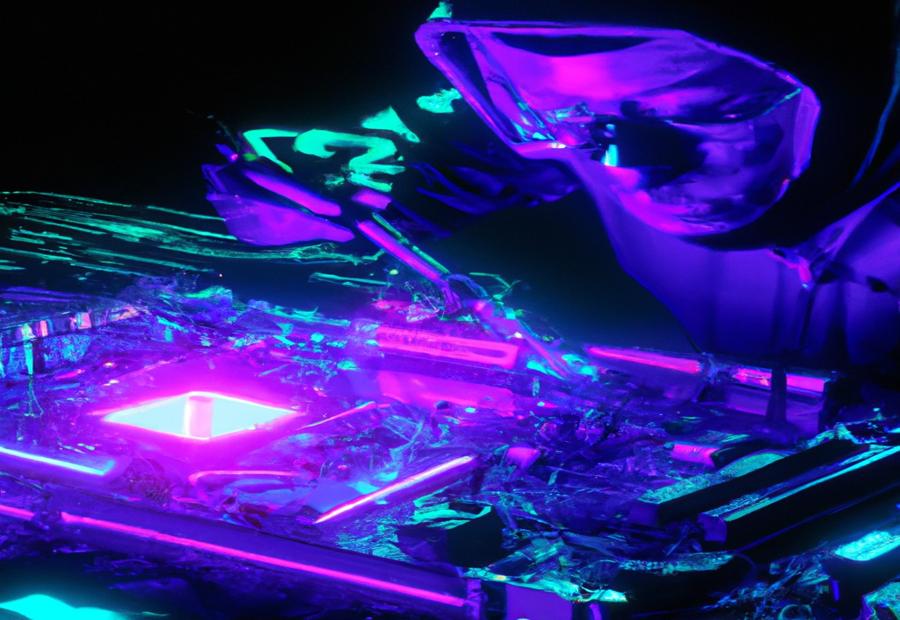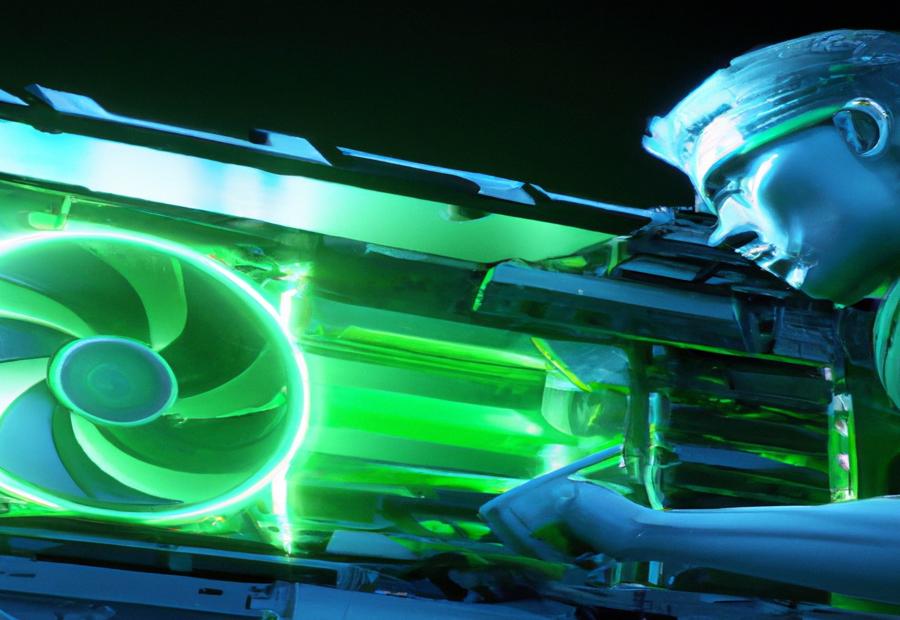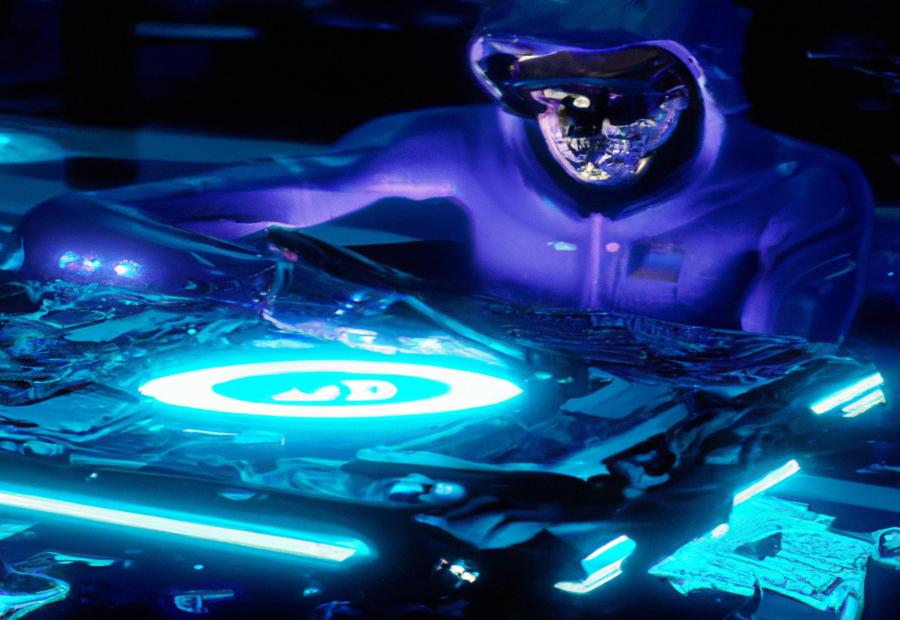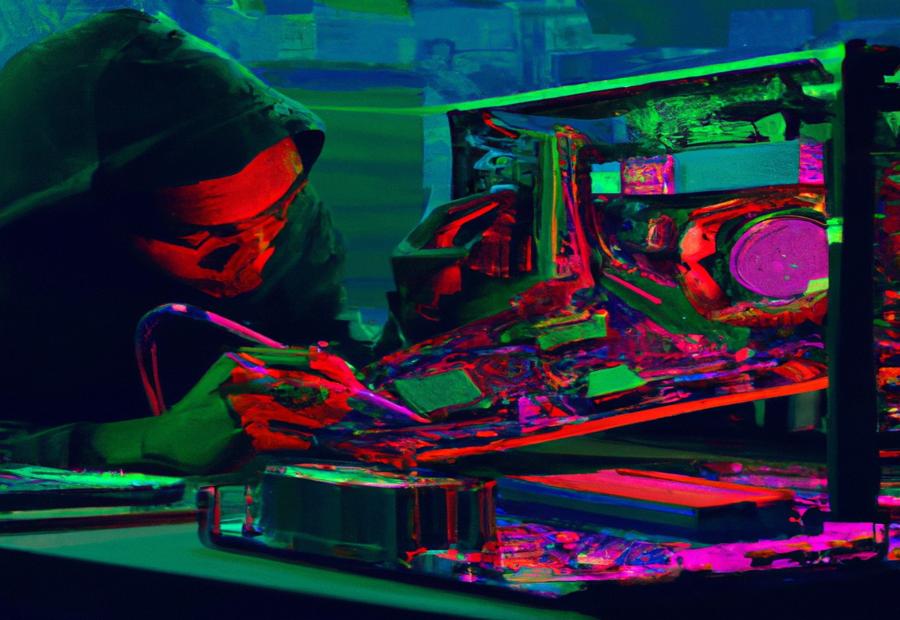Key Takeaway:
- Nvidia has made significant advancements in AI and machine learning with its latest GPU technology, which includes self-optimizing compute services and optimized models for cost savings and performance gains. OctoML launched OctoAI, a self-optimizing compute service for AI with a focus on generative AI, allowing businesses to build ML-based applications and put them into production without worrying about infrastructure. NVIDIA GPUs helped develop a neural network that could recognize cats using GPUs instead of CPUs and dominated the AI chips market with sales of GPUs for data centers reaching $6.7 billion in the last financial year.
- Nvidia has collaborated with industry leaders to deliver purpose-built infrastructure, standardized, integrated AI stacks that help organizations to develop, deploy, and manage diverse AI workloads anywhere. This includes reference workflows for generative AI and digitalizing smart factories for electronics manufacturers, with collaborations resulting in Foxconn Industrial Internet automating significant portions of its circuit-board quality-assurance inspection points while utilizing NVIDIA Metropolis. Dell Technologies, NVIDIA, and VMware have worked together to provide easy deployment of AI workloads alongside existing applications in VMware-virtualized data centers.
- Techtime is a website that collects personal and anonymous data for business purposes to enhance user experience, digital marketing, and search engine optimization. Techtime uses hosting providers, cloud-based security and web performance processing, data centers, and other third-party services to ensure compliance with GDPR requirements and data breach procedures. Users can request their data associated with their email address, and Techtime’s contact information is provided without specifying an address.
OctoML’s Latest Innovation: OctoAI

Photo Credits: Terminl.Ca by Brian Nguyen
OctoML’s latest innovation, OctoAI, promises to take AI model optimization to the next level with its self-optimizing compute service capabilities. In this section, we will explore how OctoAI can automatically optimize AI models for enhanced accuracy and improved performance gains. Additionally, we will look at the accelerated versions of foundation models like BERT and GPT-3, which ensure faster and more efficient model training. Source – Nvidia’s Latest AI GPUs.
Self-optimizing compute service for generating AI models
OctoML recently launched the cutting-edge OctoAI. It automates complex AI model building. Companies can use it to optimize performance & save costs.
A table can show features & benefits of OctoAI. Features like self-optimization & automation. Benefits like cost savings & improved performance.
| Features | Benefits |
|---|---|
| Self-optimization | Cost savings |
| Automation | Improved performance |
Foundation Versions Supported list popular versions. Performance Gains & Cost Savings Achieved show gains & savings.
OctoAI is an optimal solution for adopting AI tech. It offers optimized versions with cost savings & improved performance. Self-optimizing compute service saves costs & boosts performance.
Automatically optimizes models for cost savings and performance gains
OctoML’s OctoAI is a ground-breaking, self-optimizing compute service. It revolutionizes AI model generation with automated optimization. This remarkable platform accelerates BERT and ResNet models.
OctoAI’s self-optimization studies each model’s computational requirements. It then chooses the best algorithm to run the application accurately and efficiently. It uses machine learning and optimization capabilities for cost savings and performance gains.
OctoAI makes model-building easy and reduces scaling expenses. It fine-tunes AI models quickly and saves on computing resources. Businesses can use its fully-managed service for tailored software development of ML applications.
OctoAI helps businesses across many industries optimize their operations. It keeps them up-to-date with advances in AI technology. This intelligent platform gives AI models a turbo boost. It automatically optimizes models for cost savings and performance gains.
Accelerated versions of popular foundation models like Dolly 2 and Whisper
OctoML has unveiled OctoAI, their latest innovation. It’s a self-optimizing compute service that creates AI models. It helps to save costs and increase performance.
Moreover, they offer sped up versions of popular foundation models such as Dolly 2 and Whisper. These come with unique features and functionalities, which are shown in the table below.
| Foundation Model | Accelerated Version | Key Features |
|---|---|---|
| Dolly 2 | Dolly 2X | Supports multi-platform training |
| Whisper | Whisper Optima | Optimizes inference engine for fast execution speed |
The table highlights the unique capabilities of the Accelerated Versions. For example, Dolly 2X is for multi-platform training. Users can make multiple model variants quickly.
Whisper Optima’s inference engine is optimized for fast speed. It performs better than the original version.
OctoML is making advancements in AI modeling using their self-optimizing compute service. This has resulted in new technologies like the accelerated versions of Dolly 2 and Whisper. They provide improved capabilities and better results for users’ AI projects.
NVIDIA’s Latest Advancements in AI Technology

Photo Credits: Terminl.Ca by Eugene Nelson
NVIDIA, a leading producer of GPUs, has released a new line of products designed to optimize electronics repairs through AI technology. In this section, we’ll explore NVIDIA’s latest advancements in AI technology, including their reference workflow for generative AI and their digitalization of smart factories for electronics manufacturers. We’ll also take a close look at NVIDIA’s flagship products, including Omniverse, Isaac Sim, and Metropolis, and how they are dominating the GPU market through their specialized products.
Reference workflow for generative AI, 3D collaboration, simulation, and autonomous machines
NVIDIA is pioneering cutting-edge tech in AI, such as generative AI, 3D collaboration, simulation, and autonomous machines. Their reference workflow combines many of their latest tech developments. NVIDIA Omniverse, NVIDIA Isaac Sim, and NVIDIA Metropolis are some of their stand-out projects.
These are the result of collaborations between NVIDIA, Dell Technologies, and VMware. Their purpose-built infrastructure lets you quickly deploy diverse AI workloads with a unified stack.
One example of NVIDIA’s transformative tech is in electronic repairs. Fixably use their specialized GPUs to optimize repairs with generative algorithms. This increases productivity, reduces costs, and speeds up turnaround times.
NVIDIA’s advanced tech is driving AI forward. They are set to remain a leading AI industry force.
NVIDIA Omniverse, NVIDIA Isaac Sim, and NVIDIA Metropolis
NVIDIA is a pioneer in revolutionizing Artificial Intelligence. Their cutting-edge technologies like NVIDIA Omniverse, NVIDIA Isaac Sim, and NVIDIA Metropolis have greatly impacted this field. These solutions provide generative AI workflows, 3D collaboration, simulation, and autonomous machines.
To demonstrate the features of these amazing technologies, NVIDIA has provided a comprehensive table:
| Technology | Main Features | Application |
|---|---|---|
| NVIDIA Omniverse | Digitalizing smart factories | Electronics manufacturers |
| NVIDIA Isaac Sim | Simulating environments | Training robots autonomously |
| NVIDIA Metropolis | Standardized integrated AI stack | Easy deployment and management of diverse AI workloads |
NVIDIA Omniverse focuses on digitalizing smart factories for electronics manufacturers. NVIDIA Isaac Sim simulates environments with realistic physics to train robots autonomously. NVIDIA Metropolis offers a standardized integrated AI stack for easy deployment and management of diverse AI workloads.
These unique technologies offer a comprehensive solution that lets manufacturers simulate scenarios before launching products. The Metropolis suite is especially useful, as it can easily integrate different AI workloads.
By offering a standardized approach to simulation and AI training with Isaac Sim and integration with Metropolis, companies can get more benefits than using individual solutions from various vendors.
To conclude, NVIDIA Omniverse, NVIDIA Isaac Sim, and NVIDIA Metropolis are revolutionary technologies in the AI world. Their offerings of generative AI workflows, 3D collaboration, simulation, and autonomous machines contribute to the successful digitalization of industries. These technologies have certainly made significant progress in advancing artificial intelligence.
Digitalizing smart factories for electronics manufacturers
Smart factories for electronics manufacturers are being transformed through digitalization with the latest AI tech. NVIDIA’s Omniverse, Isaac Sim, and Metropolis give these factories reference workflows for generative AI, 3D collaboration, simulation, and autonomous machines. Dell Technologies, NVIDIA, and VMware are collaborating to help manufacturers optimize and improve efficiency with purpose-built infrastructure.
Running AI programs on PCs with RTX graphics can speed up the process. A standardized, integrated AI stack lets manufacturers deploy and manage diverse AI workloads. Nvidia AI GPUs can save time and prevent manual errors when repairing electronics.
Integrating AI into digitalizing smart factories is beneficial for data collection. Sensitive consumer data is protected and compliant with GDPR, making sure current electronics manufacturers can grow with this innovation.
Dominating the AI chips market through specialized GPUs
NVIDIA has taken over the AI chip market with their special GPUs. Created for AI applications, these GPUs process data rapidly and efficiently, making them a top supplier of AI chips and a clear leader over their opponents.
Innovating is a constant for NVIDIA in the AI technology field. Producing products like Omniverse – a platform for generative AI, 3D collaboration, simulation and autonomous machines – and Isaac Sim – a tool for creating and testing autonomous robots.
Working with Dell Technologies and VMware has helped NVIDIA to form an AI stack, making it easier for businesses to deploy and manage different AI workloads.
There is no shock that NVIDIA rule the market. According to Mercury Research, they account for 80% of the specialized GPU market share for AI applications.
Collaborations for AI Optimization

Photo Credits: Terminl.Ca by Joseph Adams
Collaborations for AI optimization aim to find the most effective ways to utilize AI programs. This section showcases partnerships between Dell Technologies, NVIDIA, and VMware, which includes running AI applications on NVIDIA’s RTX graphics equipped Windows PCs, providing dedicated infrastructure for AI projects, and utilizing a standardized and integrated AI stack for various workloads.
Running AI programs on Windows PCs equipped with NVIDIA’s RTX graphics
NVIDIA’s RTX graphics and Windows have joined forces, making AI programs run more smoothly than ever. These graphics are optimized for deep learning with a focus on speed and efficiency. Perfect for Windows users wanting to run AI programs!
Studies show that RTX GPUs and Windows OS combine to make a great platform for complex models. This means machine learning models take less time to compute. Plus, developers can access data from one software tool instead of toggling between several.
Windows, Dell Technologies, VMware, and NVIDIA have formed a strong team. They provide a standardized AI stack for diverse workloads, saving business costs and increasing performance.
NVIDIA, Dell Technologies, and VMware have joined forces to create the perfect environment for AI project implementations. When Windows PCs are equipped with NVIDIA RTX graphics, users can expect an enhanced AI experience.
Purpose-built infrastructure for AI projects with collaborations from Dell Technologies, NVIDIA, and VMware
Dell Technologies, NVIDIA, and VMware have joined forces for a special purpose: to make infrastructure for AI projects. Their collaboration has resulted in an infrastructure that makes deploying and managing different AI workloads a piece of cake! Check out the table below for the crucial details of this amazing collaboration:
| Feature | Collaboration Info |
|---|---|
| Goal | Infrastructure for AI tasks |
| Teams | Dell Technologies, NVIDIA, and VMware |
| Benefits | Simple deployment and management of various AI jobs |
These partnerships help give a single, integrated AI stack that works with popular frameworks like TensorFlow, PyTorch, and MXNet. They also aid in setting up tough data centers that can manage advanced NLP models. With standards-based platforms for AI infrastructures, it’s simpler to maintain and encourages better links and communication between departments.
Pro Tip: Dell Technologies, NVIDIA’s Latest AI GPUs, and VMware’s collaborations build infrastructure for AI projects, providing an easy, unified, and linked AI stack.
Standardized and integrated AI stack for easy deployment and management of diverse AI workloads
A standardized, integrated AI stack is essential for managing AI workloads efficiently. NVIDIA, Dell Technologies, and VMware have put together a purpose-built infrastructure stack that simplifies the deployment and management of AI. This stack sets the stage for faster adoption of AI and boosts business productivity.
Each component of the stack is important. It includes purpose-built infra, high-performance hardware, a robust software stack, and fast networking tech. All these parts work together to deploy and manage AI apps like ML, NLP, and DL quickly.
Standardizing the framework reduces the complexity of creating custom solutions with proprietary frameworks. This approach provides an efficient way to handle diverse workloads with standard tools, which is great news for industries wanting to integrate advanced tech into their existing portfolios.
As an example, Dell Technologies and NVIDIA helped an electronics manufacturer identify defects faster during their QA process. By deploying unique software on top of NVIDIA chips’ architecture, they could analyze data without slowing down production. This saved the company time and enabled a more efficient workflow for their workers.
Techtime is dedicated to managing personal data ethically and responsibly. We follow GDPR requirements and data breach procedures to protect it.
Techtime’s Focus on Data Collection and Protection

Photo Credits: Terminl.Ca by Bryan Hernandez
Techtime’s latest efforts in collecting and protecting data have been contributing to its mission of optimizing electronics repairs with Nvidia’s latest AI GPUs. Techtime’s approach towards data collection protects user privacy and enables business progress by incorporating various practices to ensure GDPR requirements and data breach procedures are in place. This includes clear communication and consent checkboxes for personal data collection, using third-party services for web performance processing, and storing data in secure data centers.
Personal and anonymous data collection for business purposes
Data collection is essential for businesses. It involves collecting information from various sources to make decisions or improve performance. Anonymous data collection has become popular as it can help businesses understand consumer behavior, preferences, and opinions while still respecting privacy. It can help companies create better products, marketing strategies, and tailor offerings to customers’ needs.
However, it is vital to be compliant with data privacy regulations like GDPR. Companies must state why they are collecting data and get explicit consent before doing so. Hosting providers, cloud-based security, and web performance processing should be used, as well as data protection measures. Both personal and anonymous data collection for business purposes must be handled carefully to guarantee security.
Clear reasons and consent checkboxes for collecting personal data
Techtime is dedicated to secure data collection. We provide third-party services and cloud-based security to businesses. This helps them to meet GDPR regulations.
For companies, it’s necessary to have clear and transparent reasons for personal data collection, as well as consent checkboxes. This ensures legit reasons for data collection and individuals are aware of the purpose. Plus, it promotes transparency and people can withdraw their consent any time.
Data encryption, secure hosting providers, cloud-based security, data centers, and third-party services are essential measures to protect data. GDPR also requires businesses to keep personal data for a limited period and have plans for data breach cases.
Thanks to collaborations between Dell Technologies, NVIDIA and VMware, AI projects have become more efficient. This has been possible due to a standardized integrated AI stack, which simplifies deployment and management of workflow on purpose-built infrastructure.
Use of hosting providers, cloud-based security and web performance processing, data centers, and other third-party services
Businesses depend on a mix of external services to manage their hosting, security, and web performance needs. Cloud-based infrastructure is one way to do this. It’s easy and efficient for taking care of digital resources. Collaborating with third-party providers gives businesses access to specialized services.
To show what providers companies use, a table can be made. AWS, GCP, Dell Technologies, VMware, and NVIDIA are popular choices.
In industries like electronics repair, businesses can also work with AI service providers like OctoML or NVIDIA. This way, they can have fast access to AI models. This makes operations more efficient.
Third-party services help companies manage data storage and security. This is especially useful for data protection scenarios. It’s important to ensure GDPR compliance. This gives people more control over their personal data.
Overall, external service providers help businesses across all industries to grow and succeed.
Retaining data for as long as necessary and protecting data with GDPR requirements and data breach procedures in place.
Today’s world is dominated by data. Companies are gathering more sensitive information from their customers. It’s important to ensure this data remains secure. To do this, businesses need to keep the data only as long as necessary and comply with GDPR rules.
They can get help from hosting providers, cloud-based security services, and other third-party services that specialize in data protection. Employees must be trained in security measures and critical company documents secured against cyber-attacks.
Businesses must retain customers’ trust by protecting their privacy when collecting personal information. Cloud-based technologies can store collected data safely. AI-stack offers easy integration and deployment. Specialized processors offer optimized workloads and reduce downtimes and latencies.
By investing in protecting and managing collected data, companies can gain customer trust, meet legal and regulatory requirements, and make the most of their data resources.
Optimizing Electronics Repairs with Nvidia’s Latest AI GPUs:
- ✅ NVIDIA dominates the AI chips market. (Source: Wired)
- ✅ Dell Technologies, NVIDIA, and VMware are collaborating to make it easier for enterprises to develop, deploy, and manage diverse AI workloads anywhere. (Source: Dell) – IDC predicts that 85% of enterprises worldwide will be using AI, including ML, NLP, and pattern recognition, by 2026. However, the lack of purpose-built infrastructure often causes AI projects to fail. The Dell Validated Design for AI with VMware vSphere with Tanzu and the NVIDIA AI Enterprise software suite is a standardized and integrated AI stack that helps organizations capitalize on the latest AI technologies. The integrated solution allows IT teams to run accelerated and containerized AI workloads alongside existing applications in their VMware-virtualized data centers. NVIDIA AI Enterprise 2.0, the latest version of the software, is now available with Dell AI solutions and includes AI frameworks.
- ✅ NVIDIA and Microsoft are collaborating to allow consumers to run AI programs on Windows PCs equipped with Nvidia’s RTX graphics. (Source: PCMag) – Nvidia has been working to deliver “GPU acceleration and support” for its entire AI software stack inside the Windows Subsystem for Linux (WSL). The Microsoft Olive toolchain can help integrate AI models into Windows applications by optimizing and exporting Pytorch deep learning models to the ONNX format. The latest optimizations in Release 532.03 drivers, combined with Olive optimized models, can deliver big boosts in AI performance. The new drivers can boost the performance of the AI image generator Stable Diffusion by over two times. This paradigm-changing model could allow consumers to run AI programs on laptops without connecting to the internet.
- ✅ Nvidia has introduced a reference workflow combining its technologies for generative AI, 3D collaboration, simulation, and autonomous machines to help manufacturers plan, build, operate, and optimize their factories. (Source: NVIDIA News) – The technologies included in the workflow are NVIDIA Omniverse, NVIDIA Isaac Sim, and NVIDIA Metropolis. The workflow is being used by electronics manufacturers such as Foxconn Industrial Internet, Innodisk, Pegatron, Quanta, and Wistron to optimize their workcell and assembly line operations while lowering production costs. Foxconn Industrial Internet is working with NVIDIA Metropolis ecosystem partners to automate significant portions of its circuit-board quality-assurance inspection points. Nvidia founder and CEO Jensen Huang showcased a demo of an entirely digitalized smart factory in his keynote address at COMPUTEX, which is an industry first for electronics makers.
- ✅ OctoML launched in 2019 with a focus on optimizing machine learning models and has since added features to help deploy ML models and raised $132 million. (Source: TechCrunch) – OctoML is launching OctoAI, a self-optimizing compute service for AI with a focus on generative AI. OctoAI helps businesses build ML-based applications and put them into production without worrying about infrastructure. Users prioritize their needs, and OctoAI chooses the right hardware, automatically optimizing models for cost savings and performance gains. OctoML offers accelerated versions of popular foundation models like Dolly 2 and Whisper.
FAQs about Optimizing Electronics Repairs With Nvidia’S Latest Ai Gpus
What is the focus of OctoML and what service are they launching?
OctoML launched in 2019 with a focus on optimizing machine learning models and they are launching OctoAI, a self-optimizing compute service for AI with a focus on generative AI.
How does OctoAI operate and what benefits can businesses gain using it?
OctoAI helps businesses build ML-based applications and put them into production without worrying about infrastructure. Users prioritize their needs and OctoAI chooses the right hardware, automatically optimizing models for cost savings and performance gains. This reduces the time, cost, and complexity of AI deployments and eliminates the need for businesses to hire expensive data scientists or AI engineers.
How are electronics manufacturers utilizing NVIDIA’s technologies to optimize their factories?
Electronics manufacturers such as Foxconn Industrial Internet, Innodisk, Pegatron, Quanta, and Wistron are utilizing NVIDIA Omniverse, NVIDIA Isaac Sim, and NVIDIA Metropolis to optimize their workcell and assembly line operations while lowering production costs. For example, Foxconn Industrial Internet is working with NVIDIA Metropolis ecosystem partners to automate significant portions of its circuit-board quality-assurance inspection points.
Why are GPUs better at powering AI compared to CPUs?
GPUs are specialized for intense workloads like 3D rendering, and thus are better at powering AI because AI tasks are similarly intense and require significant computing power.
How are NVIDIA and Microsoft collaborating to allow consumers to run AI programs on Windows PCs?
NVIDIA and Microsoft are collaborating to deliver “GPU acceleration and support” for its entire AI software stack inside the Windows Subsystem for Linux (WSL). The Microsoft Olive toolchain can help integrate AI models into Windows applications by optimizing and exporting Pytorch deep learning models to the ONNX format. The latest optimizations in Release 532.03 drivers, combined with Olive optimized models, can deliver big boosts in AI performance.
How are Dell Technologies, NVIDIA, and VMware working together to make it easier for enterprises to develop, deploy, and manage diverse AI workloads anywhere?
Through their collaboration, Dell Technologies, NVIDIA, and VMware have created the Dell Validated Design for AI with VMware vSphere with Tanzu and the NVIDIA AI Enterprise software suite. This standardized and integrated AI stack helps organizations capitalize on the latest AI technologies, run accelerated and containerized AI workloads alongside existing applications in their VMware-virtualized data centers, and includes AI frameworks.